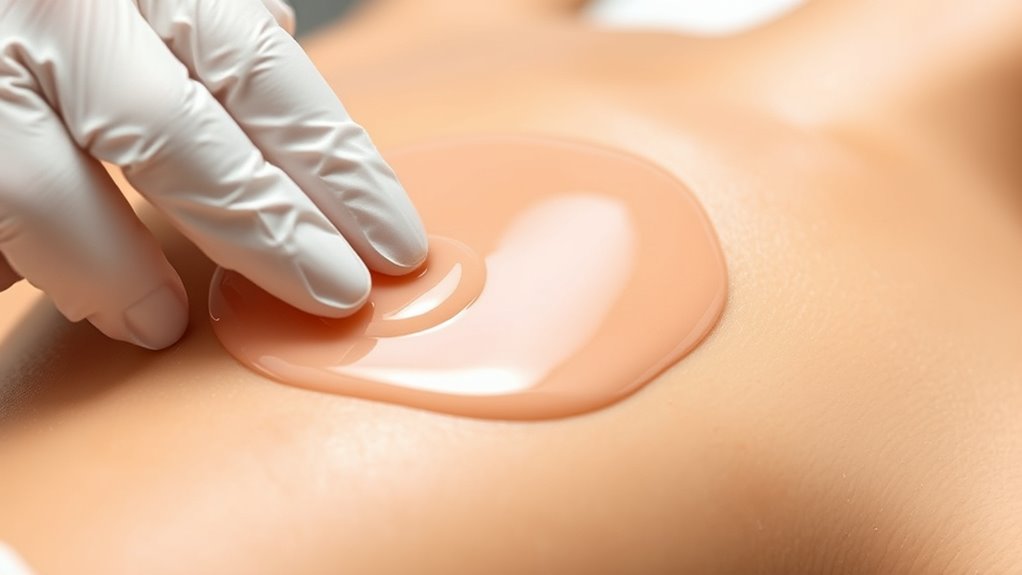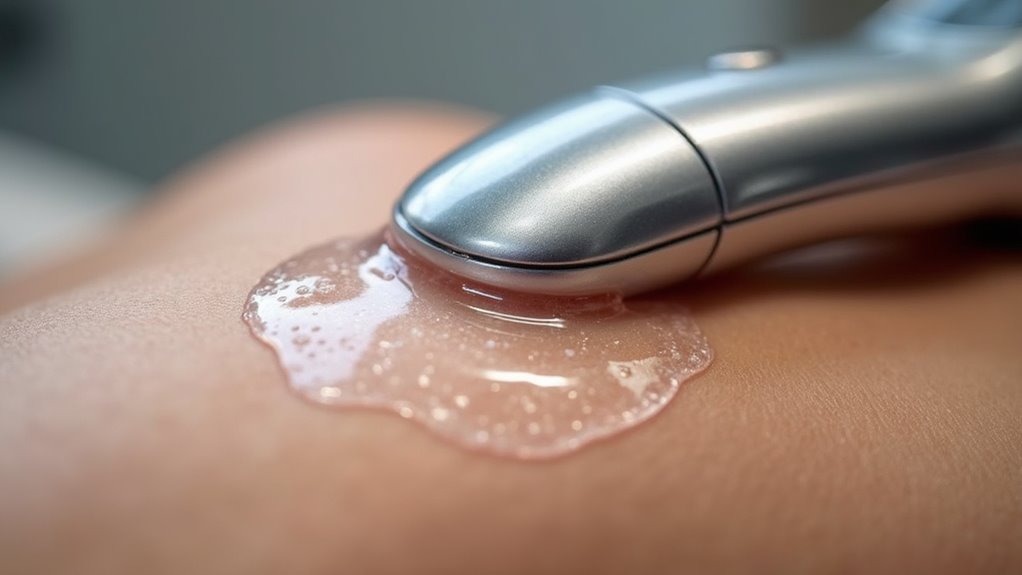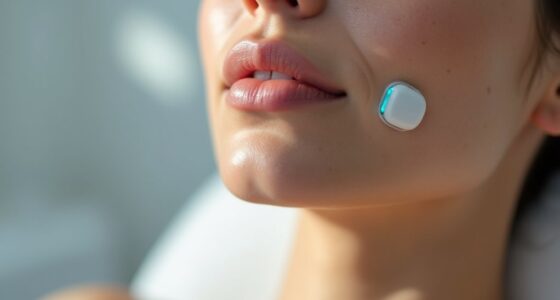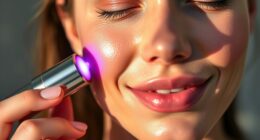Skipping conductive gel during RF or microcurrent treatments can lead to poor energy transfer, decreased effectiveness, and discomfort. Without the gel, the device may not contact your skin properly, causing uneven results and potential skin irritation or redness. Proper gel application guarantees safe, smooth therapy and enhances outcomes. If you want to discover how to choose and apply the right gel for best results, keep exploring further.
Key Takeaways
- Conductive gel ensures optimal energy transfer, improving treatment effectiveness and device performance during RF or microcurrent sessions.
- Skipping gel increases skin friction, leading to irritation, redness, discomfort, and potential surface damage.
- Proper gel application reduces resistance, allowing deeper device penetration and better results.
- Using the right, hypoallergenic gel minimizes skin irritation and enhances patient safety.
- Removing gel gently after treatment prevents residue buildup, skin irritation, and maintains device functionality.
The Role of Conductive Gel in Ensuring Effective Energy Transfer

Conductive gel plays a crucial role in guaranteeing effective energy transfer during RF or microcurrent treatments. Proper electrode contact depends heavily on the gel’s consistency, which should be smooth and spreadable for ideal results. If the gel is too thick, it can create gaps between the electrode and skin, reducing energy flow. Conversely, if it’s too runny, it may leak and compromise treatment precision. Achieving the right gel consistency ensures consistent electrical conductivity, allowing the device’s energy to penetrate deeper and work more effectively. This not only enhances treatment outcomes but also minimizes discomfort. Remember, a well-chosen gel helps maintain continuous contact, making your sessions more comfortable and efficient. Proper application is key to maximizing the benefits of RF and microcurrent therapies. Additionally, selecting a gel with adequate conductivity ensures optimal energy transfer and better treatment results.
Preventing Skin Irritation and Discomfort During Treatments

Using the right conductive gel helps reduce skin friction and prevents irritation during treatments. It also improves equipment conductivity, making the process smoother and more comfortable. By focusing on these points, you can minimize discomfort and protect your skin throughout the session. Additionally, selecting a gel that complements the specific treatment type can enhance overall results and ensure a more effective experience.
Reduces Skin Friction
Applying conductive gel with RF or microcurrent treatments helps reduce skin friction, which can otherwise cause irritation and discomfort during the procedure. When you use the right gel, it minimizes friction between your skin and the device, preventing unnecessary irritation. Plus, gel compatibility with your skin ensures ideal skin hydration, making the treatment smoother and more comfortable. To see how different factors influence your experience, consider this table:
| Factor | Effect on Skin Friction | Benefit |
|---|---|---|
| Gel Consistency | Thicker gels reduce friction | Less irritation |
| Skin Hydration | Well-hydrated skin lowers friction | Comfort during treatment |
| Gel Compatibility | Properly formulated gels work better | Enhanced treatment quality |
| Temperature | Warm gels decrease friction | Smoother glide |
| Application Method | Even application minimizes friction | Consistent results |
Using the right conductive gel enhances your comfort and skin safety during RF or microcurrent treatments. Maintaining skin health can further improve treatment outcomes and reduce irritation.
Enhances Equipment Conductivity
To guarantee your RF or microcurrent treatments run smoothly, it’s essential to optimize equipment conductivity. Using conductive gel ensures the electrical current flows efficiently between the device and your client’s skin. Many conductive gel myths suggest you can skip gel altogether, but this can lead to poor conductivity and inconsistent results. Conductive gels reduce resistance, helping the device deliver maximum effectiveness. If you’re considering gel alternative options, be cautious—many substitutes don’t provide the same level of conductivity and can cause uneven treatment. Proper gel application maintains a steady current, prevents skin irritation, and enhances overall comfort. Additionally, choosing high-quality best anime movies can provide a relaxing break from your skincare routine. Don’t fall for myths that suggest skipping gel; investing in quality conductive gel ensures ideal equipment performance and safer, more effective treatments.
Minimizes Treatment Discomfort
Properly selected conductive gel minimizes treatment discomfort by creating a smooth, even interface between the device and your client’s skin. When the gel guarantees electrode compatibility, it reduces friction and prevents skin irritation during RF or microcurrent sessions. Additionally, high-quality gels with good gel longevity maintain their conductive properties throughout the treatment, avoiding interruptions caused by drying or breakdown. This consistent conductivity minimizes discomfort and enhances the overall experience. Using the right gel also prevents uneven energy distribution, which can cause hot spots or irritation. By choosing a gel designed for your equipment and treatment duration, you help your clients experience less discomfort, making treatments more comfortable and effective. Proper gel selection is key to a smooth, irritation-free session. Incorporating data-driven strategies can further optimize gel selection and treatment outcomes, ensuring a more precise and effective approach to client care.
How Conductive Gel Enhances Treatment Outcomes

Conductive gel markedly improves treatment outcomes by ensuring ideal transmission of RF or microcurrent energy into the skin. Proper electrode placement depends on consistent contact, which gel facilitates. Without it, energy may disperse, reducing effectiveness. Here’s how gel enhances results:
Conductive gel ensures optimal energy transmission and consistent contact for effective treatments.
- Optimizes contact for precise electrode placement, leading to targeted treatment.
- Reduces resistance, allowing more efficient energy flow into deeper tissues.
- Prevents skin irritation caused by dry or uneven contact.
- Eliminates gel alternatives that might be too thick, sticky, or ineffective, ensuring consistent conductivity.
Using conductive gel guarantees the energy reaches the right layers, maximizing your treatment’s benefits. It’s essential for reliable results and avoiding compromised outcomes caused by poor electrode contact or inadequate conductivity.
Risks and Downsides of Skipping the Gel

Skipping the gel can cause your treatment to be less effective because the energy won’t transfer properly. Without it, you also risk skin irritation or discomfort during the procedure. It’s important to understand these downsides to guarantee safe and ideal results. Using the proper tools and techniques ensures optimal energy transfer and a more comfortable experience.
Ineffective Energy Transfer
When you skip using conductive gel during RF or microcurrent treatments, the energy transfer becomes inefficient, which can compromise the effectiveness of the procedure. Without proper gel, electrode adhesion suffers, risking inconsistent contact. The gel’s consistency is vital; a thin or dry layer reduces conductivity. Here are four ways skipping gel impacts you:
- Reduced energy flow, leading to less noticeable results.
- Poor electrode adhesion, causing uneven treatment.
- Increased risk of device malfunction due to inconsistent contact.
- The need for longer treatments to see any benefits.
Using the right gel ensures maximum conductivity, better electrode adhesion, and efficient energy transfer. Skipping it diminishes treatment quality and may require repeated sessions, wasting your time and money.
Skin Irritation Risks
Without proper conductive gel, your skin is more vulnerable to irritation and discomfort during RF or microcurrent treatments. When the skin isn’t adequately hydrated, it becomes more sensitive and prone to redness or burning sensations. Skipping the gel also risks damaging the skin’s surface, especially if the product isn’t compatible with your device. Using the right conductive gel ensures ideal skin hydration, reducing friction and preventing irritation. It helps create a smooth interface between the device and your skin, minimizing the risk of redness or inflammation. Without it, you may experience discomfort or even long-term irritation, which can compromise your treatment results. Always choose a product that’s compatible with your device and skin type to keep your skin safe and comfortable during treatments. Recognizing angel number signals can also help you better understand your emotional and spiritual readiness for such self-care routines.
Choosing the Right Conductive Gel for Your Sessions

Choosing the right conductive gel is essential for maximizing the effectiveness of your RF or microcurrent sessions. To guarantee optimal results, focus on these key factors:
- Device Compatibility: Confirm the gel works with your specific device to prevent issues like poor conductivity or damage.
- Gel Longevity: Select a gel that maintains its conductive properties throughout your session without drying out quickly.
- Skin Compatibility: Use a hypoallergenic gel to reduce irritation and ensure comfort.
- Application Ease: Opt for a gel that spreads smoothly and evenly, making application straightforward and mess-free. Proper gel selection can also help prevent dampening device performance during treatments.
Tips for Proper Application and Removal of Conductive Gel

Applying conductive gel properly guarantees your treatment is effective and comfortable. Use proper application techniques by applying a generous, even layer over the treatment area to ensure ideal conductivity. Avoid thick or uneven layers that can disrupt the flow of microcurrent or RF energy. During application, keep the gel moist but not overly runny, which helps maintain consistent contact. When it’s time to remove the gel, follow proper removal methods by gently wiping the area with a damp cloth or soft towel. Avoid scrubbing or using harsh cleansers that could irritate your skin. Thorough removal prevents residue buildup, ensuring your skin stays clean and prepared for future sessions. Additionally, choosing the right tuning options can optimize your device’s performance for better results. Proper application and removal are key to maximizing results and minimizing discomfort.
Frequently Asked Questions
Can I Use Alternative Substances Instead of Conductive Gel?
You might wonder if you can use alternative lubricants or gel substitutes instead of conductive gel during RF or microcurrent treatments. While some products claim to work, they often lack the necessary conductivity, reducing effectiveness and possibly causing discomfort. It’s best to stick with recommended conductive gels designed for these procedures. Using proper gel guarantees maximum contact, safety, and results, so avoid unproven alternatives for the best outcome.
How Often Should I Replace Conductive Gel During Treatments?
Think of your conductive gel like the fuel for a car—without fresh, effective gel, your treatment can stall. You should replace the gel regularly to maintain treatment consistency, typically after each session or when it starts to dry out or become contaminated. This guarantees smooth conductivity and ideal results. Consistent gel replacement keeps your treatments effective and your client’s experience safe and comfortable.
Does Conductive Gel Affect the Longevity of RF or Microcurrent Devices?
Conductive gel compatibility markedly affects your device’s longevity. Using the right gel guarantees proper contact and prevents damage, whereas incompatible gels can lead to corrosion or malfunction. Factors influencing device longevity include consistent maintenance, clean electrodes, and correct application. Skipping or using unsuitable conductive gel may cause unnecessary wear or damage, ultimately reducing your RF or microcurrent device’s lifespan. Always choose quality gel to protect your investment and ensure ideal performance.
Are There Specific Ingredients to Avoid in Conductive Gels?
When selecting conductive gel, you should consider ingredient safety and gel formulation. Avoid gels with harsh chemicals, fragrances, or alcohol, as these can irritate your skin and compromise device performance. Choose gels with safe, skin-friendly ingredients that guarantee good conductivity without causing allergic reactions. Proper gel formulation enhances comfort and effectiveness, preventing skin damage and ensuring your RF or microcurrent treatments deliver ideal results.
How Does Conductive Gel Impact Treatment Session Duration?
Conductive gel plays a crucial role in your treatment session by improving gel application, ensuring better contact with the skin. This enhances treatment efficiency, allowing the RF or microcurrent devices to work more effectively. Without proper gel application, you might experience inconsistent results or longer sessions. Using quality conductive gel helps optimize the treatment duration, making each session quicker and more effective, so you get the best results in less time.
Conclusion
Skipping conductive gel can compromise your treatment’s effectiveness and comfort. Studies show that using the right gel improves energy transfer by up to 40%, ensuring better results and less discomfort. Don’t risk skin irritation or subpar outcomes—always apply the gel properly. By choosing quality gel and following proper application tips, you maximize benefits and minimize risks. Remember, your skin deserves the best care, so never skip this small but crucial step for ideal RF or microcurrent treatments.









